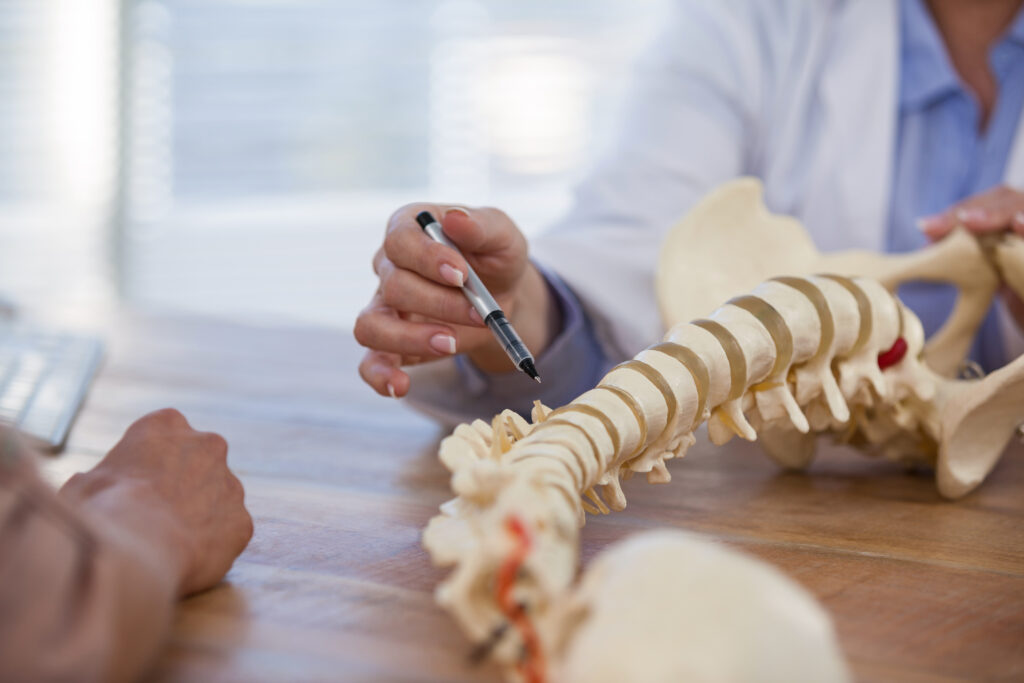Scoliosis is a condition that affects the curvature of the spine, leading to a lateral or sideways deviation from the normal straight alignment of the spine. While scoliosis is a well-recognized medical condition, its exact causes remain somewhat enigmatic. Dr. Andrew Strauss explains the main causes of scoliosis, including genetic factors, environmental influences, and the intriguing concept of asynchronous growth.
Genetic Factors as one of the main causes of scoliosis
One of the primary drivers of scoliosis is genetics. Scoliosis is essentially a genetic condition, and research has indeed identified specific genes that play a role in its development. However, having these genes doesn’t guarantee that an individual will develop scoliosis. Instead, these genetic factors create a predisposition. If a parent has a genetic predisposition for scoliosis, there is a statistical likelihood that their offspring may also be affected. Approximately 20% of children born to a parent with a genetic weakness may develop scoliosis, while this risk increases to around 50% if both parents carry the genetic predisposition.
To highlight the variability in scoliosis risk, consider a case where one family had eight children. Six of the children had profound scoliosis, while the remaining two had no signs of scoliosis at all. This stark contrast illustrates that genetic predisposition is not the sole determinant of scoliosis development. It remains a complex interplay of genetic and environmental factors.
Epigenetic Factors
Epigenetics refers to the influence of the environment on genetic predispositions. While genetics sets the stage, various environmental factors can trigger or exacerbate scoliosis in genetically susceptible individuals. Researchers have identified 47 different epigenetic factors that can contribute to the development or progression of scoliosis.
Examples of such environmental factors include:
- Swimming in Heated Pools: Oddly enough, infants who swim in indoor heated pools have been found to be more likely to develop scoliosis.
- Maternal Age: Children born to mothers who are older, particularly above the age of 40 or 45, face an increased risk of developing scoliosis. This suggests that maternal age at the time of birth may be a significant epigenetic factor.
- Sunlight Exposure: Scandinavian populations, who often experience prolonged periods of reduced sunlight, have a higher incidence of scoliosis. This suggests a link between low levels of vitamin D (which the body produces when exposed to sunlight) and scoliosis development.
These epigenetic factors underline the complexity of scoliosis causation, demonstrating that the condition results from a combination of genetic and environmental influences.
Asynchronous Growth
Asynchronous growth is an intriguing concept in scoliosis research. It involves the relative growth rates of the spinal cord and the bony column (vertebral bodies) in the spine. When the spinal cord does not grow at the same rate as the surrounding bones, it creates a condition where the cord is too short for the spine. This leads to a fascinating biomechanical effect.
To illustrate this concept, imagine a spine with a steel Flex Cable running through it, acting as the spinal cord. In the case of asynchronous growth, the spinal cord, represented by a wire, is too short. When force is applied to the spinal cord, the spine naturally twists into a scoliotic curve, as seen in the transcript. This phenomenon demonstrates how the growth patterns of the spinal cord and vertebral column can affect the development of scoliosis.
This asynchronous growth can be observed in approximately 30% of patients with scoliosis. Traditional treatments like exercises, bracing, and even surgery are often insufficient to correct this issue, as they don’t address the underlying spinal cord shortening. However, some innovative approaches aim to release and stretch the spinal cord to bring the spine back into alignment.
Conclusion
In conclusion, the main causes of scoliosis are multifaceted. While genetics provide a foundation for scoliosis predisposition, it’s the interplay with environmental factors that determines whether an individual develops the condition. Epigenetic factors, such as swimming in heated pools, maternal age, and sunlight exposure, can trigger or exacerbate scoliosis in genetically susceptible individuals.
Moreover, asynchronous growth, where the spinal cord’s growth lags behind that of the vertebral column, plays a pivotal role in the development of scoliosis. Understanding these causes and their complex interactions is crucial for the effective treatment of scoliosis, as it allows for a more holistic and individualized approach to address the condition. By considering all these factors, medical professionals can work towards reducing the severity of scoliosis and halting its progression. Scoliosis, once considered idiopathic or without a known cause, is gradually revealing its intricate nature and offering hope for improved treatments and outcomes.
Also read: Why I dropped Scoliosis Brace In Favor of Exercise Treatment
About:
Dr. Strauss is the director of the Hudson Valley Scoliosis Correction Center in New York. He has been actively engaged in scoliosis treatment for the past 30 years and has authored two books on the subject, Your Child Has Scoliosis and The Truth About Adult Scoliosis.
He is Vice President of the CLEAR Scoliosis Institute and a lecturer for their introductory and advanced workshops. He is certified in scoliosis bracing and in the use of scoliosis specific exercises. Dr. Strauss is a graduate of the ISICO World Masters of Scoliosis.His postgraduate studies also include a Masters Degree in Acupuncture as well as training in Grostic, Pettibon, CBP, Clinical Nutrition, Chinese Herbal Medicine, Manipulation under Anesthesia, and Electrodiagnosis.
His scoliosis practice has treated patients from 25 states and 32 other foreign countries.If you have questions about childhood and adult scoliosis and how it can be successfully treated without surgery subscribe to our channel!
